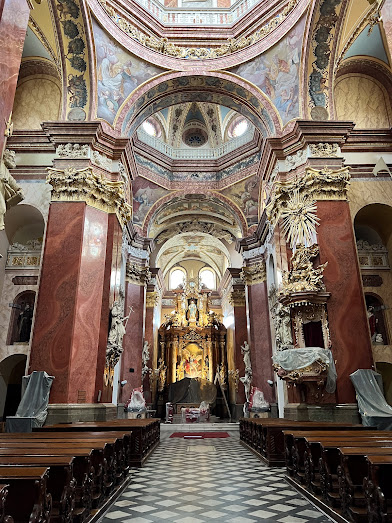Our last stop in the previous post was Trebic, a boarder town between Bohemia and Moravia. As we continued east toward the Carpathian Mountains we stopped in the village of Moravsky Krumlov. This was a last minute detour because we had heard that Alphonse Mucha's much heralded paintings, The Slav Epic, were on display here in a historic palace. They have been here for over 50 years, but Prague wanted them back at their original location where more people will see them. The wrangling has come to an end, and they moved soon after our visit.
The work is impressive. Twenty canvases each around 20' x 20', depict the mythology and historic struggles of the slavic people. He is best known for his art nouveau theater posters, the style at the time. His portrayal of human faces in the Epic depicting joy, fear and sorrow is moving.After seeing the exhibit we drove on to Mikulov in the heart of Czech wine country and an easy day trip from Vienna and Budapest across the border. It's another charming historic town of 7500 built on a hillside. We hiked to a small church perched on the top of a hill with views of the country side and vineyards.
The following day we drove to the heart of the wine country Pavlove. Being late October after the tourist season and harvest, most places were shut down or were too busy processing their grapes to be bothered by tourists. A nice priority.
From here we head north to the college city of Olomouc, the historic capital of Moravia. This city is strategically located about 150 miles from Prague, Wroclaw, Krakow, Bratislava, and Vienna. During the Thirty Years war (1618-1648) Bohemia and Moravia were at the center of religious, political, and dynastic competition and Olomouc was invaded multiple times.
After the Reformation of Martin Luther and conflict between Protestants (mostly Lutheran) and Catholics, peace was established by dividing the Holy Roman Empire based on the faith of its monarchs. However, Protestantism continued to expand keeping temperatures above simmer until in 1618 several Protestant estates (noble land owners) threw two governors and their secretaries out the window of the Prague Castle in Bohemia's third "defenestration". (The first was led by the Hussites in the fifteenth century.) The Catholic king of Bohemia was then replaced with a Protestant king.
Over the three decades, what started as religious competition eventually became a power struggle between Habsburg ruled Spain and Austria, and the French house of Bourbon and their respective allies.
This was one of the most destructive wars in Europe claiming 4 - 12 millions lives and 450,000 combatants. It is suggested that 20% of Europe's population died and some areas up to 60%! The Thirty Years War was settled in 1648 at the Peace of Westphalia. The resulting balance of power realignment created greater autonomy for kingdoms in todays Germany, and Dutch independence from Spain, leading to the Netherlands Century of the 1700s. Think Dutch artists, settling New Amsterdam (eventually New York), Curacao in S.A., and Batavia in today's Indonesia among others.
The city of Olomouc is a beautiful example of baroque architecture on a medieval street plan. Like Prague, it has a town square and astronomical clock, but unlike Prague is not overrun with tourists, but instead students. There are not a lot of tourist attractions here, it is to be experienced like a student; visiting restaurants, pubs and clubs. The main town square is adorned with public art and anchored by a large Cathedral. There is also the tallest plague column in Europe, the Column of the Holy Trinity built by a benefactor in 1716.
After two nights we headed back to Prague and visited New Town, the center of which is Wenceslas Square, of the famous Christmas lyrics:
Leaving Prague, we flew to Krakow, Poland for a south to north review of that countries history and different response to christianity.

















No comments:
Post a Comment